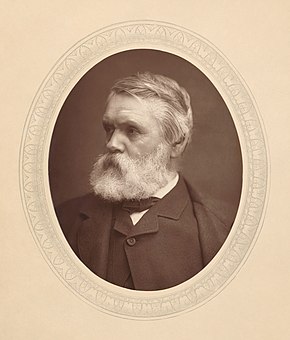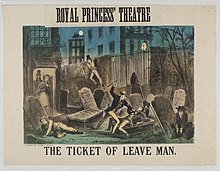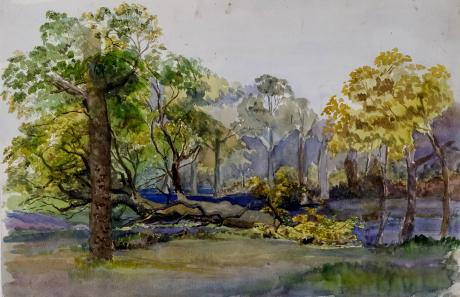"Coombe Wood Wimbledon May 1855"
Coombe is a historic neighbourhood in the Royal Borough of Kingston upon Thames in south west London, England. It sits on high ground, east of Norbiton. Most of the area was part of the former Municipal Borough of Malden and Coombe before local government re-organisation in 1965. It now shares borders with the boroughs of Merton and Sutton with, to the north, the small, inter-related neighbourhoods of Kingston Hill and Kingston Vale, beyond which is Richmond Park in Richmond; and Roehampton/Putney Vale in Wandsworth. To the east are public playing fields and Wimbledon Common.
Coombe centres on what was originally Coombe House, a large residence built in the 1750s. The house, now demolished, was located at the southwest corner of the junction of Coombe Lane (A238) and Traps Lane. Its red brick boundary walls can still be seen on the west side of Traps Lane.
The area has a long history. Roman coins and other ancient remains have been found in the area around Warren Road. Coombe appears in the Domesday Book of 1086 as Cumbe. It was held partly by Hunfrid (Humfrey) the Chamberlain and partly by Ansgot the Interpreter. Its domesday assets were: 1½ hides; 4 ploughs, 12 acres (4.9 ha) of meadow, herbage worth 4 hogs. It rendered £8.
The Neville name has long been associated with the area. In 1215 King John gave Coombe to Hugh de Nevill, and the area was known as Coombe Nevill by 1260. At the beginning of the 14th century the manor was held by William de Nevill. The 1911 Ordnance Survey map identified an estate known as Coombe Nevile at the junction of George and Warren Roads. The present-day cul-de-sac known as Coombe Neville is at the same location. Neville Avenue is a short distance away, south of Coombe Lane.
16th-century records speak of a gallows in Coombe, most likely near what is now Kingsnympton Park estate, reputedly the scene of public executions.
In the early 1700s a public house known as the Fox and Coney was established at the junction of George Road and Kingston Hill (A308). It was rebuilt in 1728 and soon thereafter was renamed the George and Dragon, operating as such until 1985, when it became the Kingston Lodge Hotel.
By 1761 Coombe was owned by John Spencer, 1st Earl Spencer.
Coombe Warren was a wild woodland on the ridge known as Coombe Hill. It was used for hunting and public fairs. 'The Coombe Wood Highwayman', Jerry Abershaw, frequented the area in the late 1700s. Being based at the "Bald Face Stag" pub, he sheltered in the woods. An 1835 map placed Coombe Warren in an area now bisected by Warren Road between Kingston Hill (A308) and Coombe Lane (A238). Portions of the Warren are now covered by the Coombe Hill estate and Coombe Wood Golf Course.
In 1822 the Admiralty opened a semaphore station in the Warren, which was part of the semaphore line from London to Portsmouth. The station has disappeared, but survived in the name of "Telegraph Cottage."
At the time of the 1865 Ordnance Survey, the area west of Warren Road remained largely open country. By 1911 two golf courses were in place, as were a number of large houses located along George Road, including Coombe Croft (now Rokeby School for Boys), Coombe Ridge (now Holy Cross Preparatory School), Coombe Court, Coombe End, Ballard Coombe and Fairview.
Numerous German bombs struck Coombe during World War II.

Coombe is a prestigious residential location, with a premium on house prices. Much of the area is occupied by two golf courses, Coombe Wood and Coombe Hill; and three private estates partly on private roads, though in practice access is mostly open, apart from Coombe Park. These are called Coombe Hill, Coombe Warren and Coombe Park. Once the site of now-demolished Coombe Warren, a 19th-century property built by architect George Devey, Coombe Hill estate today consists of Coombe Hill Road and cul-de-sacs such as Greenwood Park and Devey Close; and along Warren Road, George Road and Golf Club Drive.
The Coombe estate itself is rich in history, with objects and coins discovered that can be traced back to the Roman invasion. The area even gets a mention in the Domesday Book, where it is referred to as ‘Cumbe’. Many of the road names can be originated back to important historical figures, such as Coombe Neville, which backs onto Coombe Wood Golf Club and whose namesake is Hugh de Nevill, a nobleman to whom King John awarded the area in 1215.
In 1602, Queen Elizabeth I visited Coombe estate, unsurprising given the area’s close proximity to Tudor palace Hampton Court, and Tudor-era structures used for supplying spring water from Coombe to Hampton Court have been found in the area.
In 1761, Coombe was owned by John Spencer, the first Earl Spencer and ancestor of Princess Diana, and the father of Georgiana, Duchess of Devonshire, the subject of the acclaimed film The Duchess starring Keira Knightly.
In 1822 the navy established a telegraph station in Coombe Warren; part of the London to Portsmouth semaphore line, which became Telegraph Cottage, where future US president General Dwight D Eisenhower lived during World War II, but which is now a private gated road with accommodating six houses.
Warren House, now a prestigious venue for weddings and events, was built in 1865 for Hugh Hammersley, wealthy banker to the British Army. The house was extended in the 1880s by well-known architect George Devey.
Dame Nellie Melba, Australian soprano and the most famous singer of the Victorian era, lived in Coombe House, Devey Close in 1906 – a blue plaque commemorates her time here. She would later name her Melbourne home Coombe Cottage.
Coombe Wood is actually two small woodlands on either side of the A3 (Kingston by-pass). The Beverley Brook flows north along the edge of Coombe Wood East, and eventually into Wimbledon Common. Coombe Wood West is managed as a Local Nature Reserve by the London Wildlife Trust.
Coombe Wood West is much older than its neighbour. It consists mainly of oak and sycamore, ash, silver birch and old coppiced hazel. Rhododendron is very invasive here and has replaced the natural shrub layer through much of the wood. Surviving native shrubs include the uncommon alder buckthorn and wayfaring tree, however. Bramble, wood sage and bracken are common at ground level.Breeding birds include great spotted woodpecker and long-tailed tit.The eastern woodland is much younger, secondary woodland. The Beverley Brook is heavily shaded here and largely without plant life.

Tom Taylor (19 October 1817 – 12 July 1880) was an English dramatist, critic, biographer, public servant, and editor of Punch magazine. Taylor had a brief academic career, holding the professorship of English literature and language at University College, London in the 1840s, after which he practised law and became a civil servant. At the same time he became a journalist, most prominently as a contributor to, and eventually editor of Punch.
In addition to these vocations, Taylor began a theatre career and became best known as a playwright, with up to 100 plays staged during his career. Many were adaptations of French plays, but these and his original works cover a range from farce to melodrama. Most fell into neglect after Taylor's death, but Our American Cousin (1858), which achieved great success in the 19th century, remains famous as the piece that was being performed in the presence of Abraham Lincoln when he was assassinated in 1865.
Early years
Taylor was born into a newly wealthy family at Bishopwearmouth, a suburb of Sunderland, in north-east England. He was the second son of Thomas Taylor (1769–1843) and his wife, Maria Josephina, née Arnold (1784–1858). His father had begun as a labourer on a small farm in Cumberland and had risen to become co-owner of a flourishing brewery in Durham. After attending the Grange School in Sunderland, and studying for two sessions at the University of Glasgow, Taylor became a student of Trinity College, Cambridge in 1837, was elected to a scholarship in 1838, and graduated with a BA in both classics and mathematics. He was elected a fellow of the college in 1842 and received his MA degree the following year.

Taylor left Cambridge in late 1844 and moved to London, where for the next two years he pursued three careers simultaneously. He was professor of English language and literature at University College, London, while at the same time studying to become a barrister, and beginning his life's work as a writer. Taylor was called to the bar of the Middle Temple in November 1846. He resigned his university post, and practised on the northern legal circuit until he was appointed assistant secretary of the Board of Health in 1850. On the reconstruction of the board in 1854 he was made secretary, and on its abolition in 1858 his services were transferred to a department of the Home Office, retiring on a pension in 1876.
Writer
Taylor owed his fame and most of his income not to his academic, legal or government work, but to his writing. Soon after moving to London, he obtained remunerative work as a leader writer for the Morning Chronicle and the Daily News. He was also art critic for The Times and The Graphic for many years. He edited the Autobiography of B. R. Haydon (1853), the Autobiography and Correspondence of C. R. Leslie, R.A. (1860) and Pen Sketches from a Vanished Hand, selected from papers of Mortimer Collins, and wrote Life and Times of Sir Joshua Reynolds (1865). With his first contribution to Punch, on 19 October 1844, Taylor began a thirty-six year association with the magazine, which ended only with his death. During the 1840s he wrote on average three columns a month; in the 1850s and 1860s this output doubled. His biographer Craig Howes writes that Taylor's articles were generally humorous commentary or comic verses on politics, civic news, and the manners of the day. In 1874 he succeeded Charles William Shirley Brooks as editor.
Taylor also established himself as a playwright and eventually produced about 100 plays. Between 1844 and 1846, the Lyceum Theatre staged at least seven of his plays, including extravanzas written with Albert Smith or Charles Kenney, and his first major success, the 1846 farce To Parents and Guardians. The Morning Post said of that piece, "The writing is admirable throughout – neat, natural and epigrammatic". It was as a dramatist that Taylor made the most impression – his biographer in the Dictionary of National Biography (DNB) wrote that in writing plays Taylor found his true vocation. In thirty-five years he wrote more than seventy plays for the principal London theatres.

A substantial portion of Taylor's prolific output consisted of adaptations from the French or collaborations with other playwrights, notably Charles Reade. Some of his plots were adapted from the novels of Charles Dickens or others. Many of Taylor's plays were extremely popular, such as Masks and Faces, an extravaganza written in collaboration with Reade, produced at the Haymarket Theatre in November 1852. It was followed by the almost equally successful To Oblige Benson (Olympic Theatre, 1854), an adaptation from a French vaudeville. Others mentioned by the DNB are Plot and Passion (1853), Still Waters Run Deep (1855) and The Ticket-of-Leave Man (based on Le Retour de Melun by Édouard Brisebarre and Eugène Nus), a melodrama produced at the Olympic in 1863.Taylor also wrote a series of historical dramas (many in blank verse), including The Fool’s Revenge (1869), an adaption of Victor Hugo's Le roi s'amuse (also adapted by Verdi as Rigoletto), 'Twixt Axe and Crown (1870), Jeanne d'arc (1871), Lady Clancarty (1874) and Anne Boleyn (1875). The last of these, produced at the Haymarket in 1875, was Taylor's penultimate piece and only complete failure. In 1871 Taylor supplied the words to Arthur Sullivan's dramatic cantata, On Shore and Sea.
Like his colleague W. S. Gilbert, Taylor believed that plays should be readable as well as actable; he followed Gilbert in having copies of his plays printed for public sale. Both authors did so at some risk, because it made matters easy for American pirates of their works in the days before international copyright protection. Taylor wrote, "I have no wish to screen myself from literary criticism behind the plea that my plays were meant to be acted. It seems to me that every drama submitted to the judgment of audiences should be prepared to encounter that of readers".

Many of Taylor's plays were extremely popular, and several survived into the 20th century, although most are largely forgotten today. His Our American Cousin (1858) is now remembered chiefly as the play Abraham Lincoln was attending when he was assassinated, but it was revived many times during the 19th century with great success. It became celebrated as a vehicle for the popular comic actor Edward Sothern, and after his death, his sons, Lytton and E. H. Sothern, took over the part in revivals.
Howes records that Taylor was described as "of middle height, bearded [with] a pugilistic jaw and eyes which glittered like steel". Known for his remarkable energy, he was a keen swimmer and rower, who rose daily at five or six and wrote for three hours before taking an hour's brisk walk from his house in Wandsworth to his Whitehall office.
Some, like Ellen Terry, praised Taylor's kindness and generosity; others, including F. C. Burnand, found him obstinate and unforgiving. Terry wrote of Taylor in her memoirs:
Most people know that Tom Taylor was one of the leading playwrights of the 'sixties as well as the dramatic critic of The Times, editor of Punch, and a distinguished Civil Servant, but to us he was more than this. He was an institution! I simply cannot remember when I did not know him. It is the Tom Taylors of the world who give children on the stage their splendid education. We never had any education in the strict sense of the word yet through the Taylors and others, we were educated.
Terry's frequent stage partner, Henry Irving said that Taylor was an exception to the general rule that it was helpful, even though not essential, for a dramatist to be an actor to understand the techniques of stagecraft: "There is no dramatic author who more thoroughly understands his business".
In 1855 Taylor married the composer, musician and artist Laura Wilson Barker (1819–1905). She contributed music to at least one of his plays, an overture and entr'acte to Joan of Arc (1871), and harmonisations to his translation Ballads and Songs of Brittany (1865). There were two children: the artist John Wycliffe Taylor (1859–1925) and Laura Lucy Arnold Taylor (1863–1940). Taylor and his family lived at 84 Lavender Sweep, Battersea, where they held Sunday musical soirees. Celebrities who attended included Lewis Carroll, Charles Dickens, Henry Irving, Charles Reade, Alfred Tennyson, Ellen Terry and William Makepeace Thackeray.
Taylor died suddenly at his home in 1880 at the age of 62 and is buried in Brompton Cemetery. After his death, his widow retired to Coleshill, Buckinghamshire, where she died on 22 May 1905.

